Health Status of Mytilus chilensis from Intensive Culture Areas in Chile Assessed by Molecular, Microbiological, and Histological Analyses
Abstract
:1. Introduction
2. Results
2.1. Microbiological Analysis
2.2. Pathogens Evaluation and Histological Analyses
2.3. General Sequencing Results
2.4. Comparison between 18S rDNA Gut Eukaryotic Communities from WT and MF Groups of M. chilensis
3. Discussion
4. Materials and Methods
4.1. Site Information and Sample Collection
4.2. Microbiological Analysis
4.3. Histological Analysis
4.4. Nucleic Acids Extraction
4.5. Pathogen Analysis
4.5.1. Virus Detection
4.5.2. Bacteria Detection
4.5.3. Parasites Detection
4.6. 18S rDNA Metabarcoding
4.7. Metagenomic Analysis
4.8. Statistical Analysis
Supplementary Materials
Author Contributions
Funding
Institutional Review Board Statement
Data Availability Statement
Acknowledgments
Conflicts of Interest
References
- Ramírez, F.; Afán, I.; Davis, L.S.; Chiaradia, A. Climate impacts on global hot spots of marine biodiversity. Sci. Adv. 2017, 3, e1601198. [Google Scholar] [CrossRef] [Green Version]
- Beaugrand, G.; Edwards, M.; Raybaud, V.; Goberville, E.; Kirby, R.R. Future vulnerability of marine biodiversity compared with contemporary and past changes. Nat. Clim. Chang. 2015, 5, 695–701. [Google Scholar] [CrossRef]
- Gerard, K.; Bierne, N.; Borsa, P.; Chenuil, A.; Feral, J.P. Pleistocene separation of mitochondrial lineages of Mytilus spp. mussels from Northern and Southern Hemispheres and strong genetic differentiation among southern populations. Mol. Phylogenet. Evol. 2008, 49, 84–91. [Google Scholar] [CrossRef] [PubMed]
- Smietanka, B.; Zbawicka, M.; Sanko, T.; Wenne, R.; Burzynski, A. Molecular population genetics of male and female mitochondrial genomes in subarctic Mytilus trossulus. Mar. Biol. 2013, 160, 1709–1721. [Google Scholar] [CrossRef] [Green Version]
- Astorga, M.P. Genetic considerations for mollusk production in aquaculture: Current state of knowledge. Front. Genet. 2014, 5, 435. [Google Scholar] [CrossRef] [Green Version]
- Borsa, P.; Rolland, V.; Daguin-Thiebaut, C. Genetics and taxonomy of Chilean smooth-shelled mussels, Mytilus spp. (Bivalvia: Mytilidae). C. R. Biol. 2012, 335, 51–61. [Google Scholar] [CrossRef] [Green Version]
- Molinet Flores, C.A.; Díaz Gomez, M.A.; Arriagada Muñoz, C.B.; Cares Pérez, L.E.; Marín Arribas, S.L.; Astorga Opazo, M.P.; Niklitschek Huaquin, E.J.E. Spatial distribution pattern of Mytilus chilensis beds in the Reloncaví fjord: Hypothesis on associated processes. Rev. Chil. Hist. Nat. 2015, 88, 1–12. [Google Scholar]
- Gonzalez-Poblete, E.; Rojo, C.; Norambuena, R. Blue mussel aquaculture in Chile: Small or large scale industry? Aquaculture 2018, 493, 113–122. [Google Scholar] [CrossRef]
- Zbawicka, M.; Trucco, M.I.; Wenne, R. Single nucleotide polymorphisms in native South American Atlantic coast populations of smooth shelled mussels: Hybridization with invasive European Mytilus galloprovincialis. Genet. Sel. Evol. 2018, 50, 5. [Google Scholar] [CrossRef] [PubMed] [Green Version]
- Polsenaere, P.; Soletchnik, P.; Le Moine, O.; Gohin, F.; Robert, S.; Pépin, J.F.; Stanisière, J.Y.; Dumas, F.; Béchemin, C.; Goulletquer, P. Potential environmental drivers of a regional blue mussel mass mortality event (winter of 2014, Breton Sound, France). J. Sea Res. 2017, 123, 39–50. [Google Scholar] [CrossRef] [Green Version]
- Santibáñez, P.; Romalde, J.; Maldonado, J.; Fuentes, D.; Figueroa, J. First characterization of the gut microbiome associated with Mytilus chilensis collected at a mussel farm and from a natural environment in Chile. Aquaculture 2022, 548, 737644. [Google Scholar] [CrossRef]
- Pereira, J.C.; Chaves, R.; Bastos, E.; Leitão, A.; Guedes-Pinto, H. An efficient method for genomic DNA extraction from different molluscs species. Int. J. Mol. Sci. 2011, 12, 8086–8095. [Google Scholar] [CrossRef] [PubMed] [Green Version]
- Abolmaaty, A.; Gu, W.; Witkowsky, R.; Levin, R.E. The use of activated charcoal for the removal of PCR inhibitors from oyster samples. J. Microbiol. Methods 2007, 68, 349–352. [Google Scholar] [CrossRef] [PubMed]
- Kaufman, G.E.; Blackstone, G.M.; Vickery, M.C.L.; Bej, A.K.; Bowers, J.; Bowen, M.D.; Meyer, R.F.; Depaola, A.A. Real-Time PCR Quantification of Vibrio parahaemolyticus in Oysters Using an Alternative Matrix. J. Food Prot. 2004, 67, 2424–2429. [Google Scholar] [CrossRef] [PubMed]
- Vázquez, N.; Aranguren, R.; Dungan, C.F.; Cremonte, F. Parasites in two coexisting bivalves of the Patagonia coast, southwestern Atlantic Ocean: The Puelche oyster (Ostrea puelchana) and false oyster (Pododesmus rudis). J. Invertebr. Pathol. 2018, 158, 6–15. [Google Scholar] [CrossRef] [PubMed] [Green Version]
- Vazquez, N. Review of Parasites and Pathologies of the Main Bivalve Species of Commercial Interest of Argentina and Uruguay, Southwestern Atlantic Coast. Arch. Parasitol. 2017, 1, 112. [Google Scholar]
- Cremonte, F.; Puebla, C.; Tillería, J.; Videla, V. Histopathological survey of the mussel Mytilus chilensis (Mytilidae) and the clam Gari solida (Psammobiidae) from southern Chile. Lat. Am. J. Aquat. Res. 2015, 43, 248–254. [Google Scholar] [CrossRef]
- Lohrmann, K.B.; Bustos, E.; Rojas, R.; Navarrete, F.; Robotham, H.; Bignell, J. Histopathological assessment of the health status of Mytilus chilensis (Hupé 1854) in southern Chile. Aquaculture 2019, 503, 40–50. [Google Scholar] [CrossRef]
- Fernández Robledo, J.A.; Vasta, G.R.; Record, N.R. Protozoan parasites of bivalve molluscs: Literature follows culture. PLoS ONE 2014, 9, e100872. [Google Scholar] [CrossRef] [Green Version]
- Engelsma, M.Y.; Culloty, S.C.; Lynch, S.A.; Arzul, I.; Carnegie, R.B. Bonamia parasites: A rapidly changing perspective on a genus of important mollusc pathogens. Dis. Aquat. Organ. 2014, 110, 5–23. [Google Scholar] [CrossRef] [Green Version]
- OIE-Listed Diseases 2021: OIE—World Organisation for Animal Health. Available online: https://www.oie.int/en/animal-health-in-the-world/oie-listed-diseases-2021/ (accessed on 2 April 2021).
- Le Roux, F.; Lorenzo, G.; Peyret, P.; Audemard, C.; Figueras, A.; Vivarès, C.; Gouy, M.; Berthe, F. Molecular evidence for the existence of two species of Marteilia in Europe. J. Eukaryot. Microbiol. 2001, 48, 449–454. [Google Scholar] [CrossRef] [PubMed]
- Zrncic, S.; Le Roux, F.; Oraic, D.; Sostaric, B.; Berthe, F.C.J. First record of Marteilia sp. in mussels Mytilus galloprovincialis in Croatia. Dis. Aquat. Organ. 2001, 44, 143–148. [Google Scholar] [CrossRef] [PubMed] [Green Version]
- Wang, Z.; Lu, X.; Liang, Y.; Zheng, Z. A Marteilia-Like Parasite in Blue Mussels Mytilus edulis in China. J. Aquat. Anim. Health 2012, 24, 161–164. [Google Scholar] [CrossRef] [PubMed]
- Matozzo, V.; Ercolini, C.; Serracca, L.; Battistini, R.; Rossini, I.; Granato, G.; Quaglieri, E.; Perolo, A.; Finos, L.; Arcangeli, G.; et al. Assessing the health status of farmed mussels (Mytilus galloprovincialis) through histological, microbiological and biomarker analyses. J. Invertebr. Pathol. 2018, 153, 165–179. [Google Scholar] [CrossRef] [PubMed]
- Karagiannis, D.; Michaelidis, B.; Theodoridis, A.; Angelidis, P.; Feidantsis, K.; Staikou, A. Field studies on the effects of Marteilia sp. on growth of mussel Mytilus galloprovincialis in Thermaikos Gulf. Mar. Environ. Res. 2018, 142, 116–123. [Google Scholar] [CrossRef] [PubMed]
- Itoh, N.; Komatsu, Y.; Maeda, K.; Hirase, S.; Yoshinaga, T. First discovery of Perkinsus beihaiensis in Mediterranean mussels (Mytilus galloprovincialis) in Tokyo Bay, Japan. J. Invertebr. Pathol. 2019, 166, 107226. [Google Scholar] [CrossRef] [PubMed]
- Gauthier, J.D.; Vasta, G.R. Effects of plasma from bivalve mollusk species on the in vitro proliferation of the protistan parasite Perkinsus marinus. J. Exp. Zool. 2002, 292, 221–230. [Google Scholar] [CrossRef] [PubMed]
- Arzul, I.; Carnegie, R.B. New perspective on the haplosporidian parasites of molluscs. J. Invertebr. Pathol. 2015, 131, 32–42. [Google Scholar] [CrossRef] [PubMed] [Green Version]
- Campalans, M.; Rojas, P.; Gonzalez, M. Haemocytic Parasitosis in the farmed oyster Tiostrea chilensis Materials and Methods. Bull. Eur. Ass. Fish Pathol. 2000, 20, 31. [Google Scholar]
- Lohrmann, K.B.; Hine, P.M.; Campalans, M. Ultrastructure of Bonamia sp. in Ostrea chilensis in Chile. Dis. Aquat. Organ. 2009, 85, 199–208. [Google Scholar] [CrossRef] [Green Version]
- Norén, F.; Moestrup, Ø.; Rehnstam-Holm, A.S. Parvilucifera infectans norén et moestrup gen. et sp. nov. (perkinsozoa phylum nov.): A parasitic flagellate capable of killing toxic microalgae. Eur. J. Protistol. 1999, 35, 233–254. [Google Scholar] [CrossRef]
- Reñé, A.; Alacid, E.; Figueroa, R.I.; Rodríguez, F.; Garcés, E. Life-cycle, ultrastructure, and phylogeny of Parvilucifera corolla sp. nov. (Alveolata, Perkinsozoa), a parasitoid of dinoflagellates. Eur. J. Protistol. 2017, 58, 9–25. [Google Scholar] [CrossRef] [PubMed]
- Corbeil, S. Abalone Viral Ganglioneuritis. Pathogens (Basel, Switzerland) 2020, 9, 720. [Google Scholar] [CrossRef] [PubMed]
- Pernet, F.; Lupo, C.; Bacher, C.; Whittington, R.J. Infectious diseases in oyster aquaculture require a new integrated approach. Philos. Trans. R. Soc. London. Ser. B Biol. Sci. 2016, 371, 20150213. [Google Scholar] [CrossRef]
- Burge, C.A.; Strenge, R.E.; Friedman, C.S. Detection of the oyster herpesvirus in commercial bivalves in northern California, USA: Conventional and quantitative PCR. Dis. Aquat. Organ. 2011, 94, 107–116. [Google Scholar] [CrossRef] [Green Version]
- Mortensen, S.; Strand, Å.; Bodvin, T.; Alfjorden, A.; Skår, C.K.; Jelmert, A.; Aspán, A.; Sælemyr, L.; Naustvoll, L.-J.; Albretsen, J. Summer mortalities and detection of ostreid herpesvirus microvariant in Pacific oyster Crassostrea gigas in Sweden and Norway. Dis. Aquat. Organ. 2016, 117, 171–176. [Google Scholar] [CrossRef] [PubMed]
- Domeneghetti, S.; Varotto, L.; Civettini, M.; Rosani, U.; Stauder, M.; Pretto, T.; Pezzati, E.; Arcangeli, G.; Turolla, E.; Pallavicini, A.; et al. Mortality occurrence and pathogen detection in Crassostrea gigas and Mytilus galloprovincialis close-growing in shallow waters (Goro lagoon, Italy). Fish Shellfish Immunol. 2014, 41, 37–44. [Google Scholar] [CrossRef] [PubMed]
- Reilly, A.J.O.; Laide, C.; Maloy, A.; Hutton, S.; Bookelaar, B.; Sullivan, K.O.; Lynch, S.A.; Culloty, S.C. The role of the mussel Mytilus spp. in the transmission of ostreid herpesvirus-1 microVar. Parasitology 2018, 145, 1095–1104. [Google Scholar] [CrossRef]
- Bai, C.-M.; Rosani, U.; Li, Y.-N.; Zhang, S.-M.; Xin, L.-S.; Wang, C.-M. RNA-seq of HaHV-1-infected abalones reveals a common transcriptional signature of Malacoherpesviruses. Sci. Rep. 2019, 9, 1–11. [Google Scholar] [CrossRef] [PubMed] [Green Version]
- Crosson, L.M.; Wight, N.; VanBlaricom, G.R.; Kiryu, I.; Moore, J.D.; Friedman, C.S. Abalone withering syndrome: Distribution, impacts, current diagnostic methods and new findings. Dis. Aquat. Organ. 2014, 108, 261–270. [Google Scholar] [CrossRef]
- Hirakata, Y.; Hatamoto, M.; Oshiki, M.; Watari, T.; Kuroda, K.; Araki, N.; Yamaguchi, T. Temporal variation of eukaryotic community structures in UASB reactor treating domestic sewage as revealed by 18S rRNA gene sequencing. Sci. Rep. 2019, 9, 1–11. [Google Scholar] [CrossRef] [PubMed] [Green Version]
- Lentendu, G.; Wubet, T.; Chatzinotas, A.; Wilhelm, C.; Buscot, F.; Schlegel, M. Effects of long-term differential fertilization on eukaryotic microbial communities in an arable soil: A multiple barcoding approach. Mol. Ecol. 2014, 23, 3341–3355. [Google Scholar] [CrossRef]
- Manichanh, C.; Chapple, C.E.; Frangeul, L.; Gloux, K.; Guigo, R.; Dore, J. A comparison of random sequence reads versus 16S rDNA sequences for estimating the biodiversity of a metagenomic library. Nucleic Acids Res. 2008, 36, 5180–5188. [Google Scholar] [CrossRef] [PubMed]
- Basti, L.; Endo, M.; Segawa, S.; Shumway, S.E.; Tanaka, Y.; Nagai, S. Prevalence and intensity of pathologies induced by the toxic dinoflagellate, Heterocapsa circularisquama, in the Mediterranean mussel, Mytilus galloprovincialis. Aquat. Toxicol. 2015, 163, 37–50. [Google Scholar] [CrossRef]
- Liu, S.; Gibson, K.; Cui, Z.; Chen, Y.; Sun, X.; Chen, N. Metabarcoding analysis of harmful algal species in Jiaozhou Bay. Harmful Algae 2020, 92, 101772. [Google Scholar] [CrossRef] [PubMed]
- Mix, M.C.; Breese, W.P. A Cellular Proliferative Disorder in Oysters (Ostrea chilensis) from Chiloe, Chile, South America. J. Invertebr. Pathol. 1980, 36, 123–124. [Google Scholar] [CrossRef]
- ISO 16649-3:2015—Microbiology of the Food Chain—Horizontal Method for the Enumeration of Beta-Glucuronidase-Positive Escherichia coli—Part 3: Detection and Most Probable Number Technique Using 5-Bromo-4-Chloro-3-Indolyl-ß-D-Glucuronide. Available online: https://www.iso.org/standard/56824.html (accessed on 9 December 2021).
- BAM Chapter 9: Vibrio|FDA. Available online: https://www.fda.gov/food/laboratory-methods-food/bam-chapter-9-vibrio (accessed on 9 December 2021).
- ISO 6579-1:2017—Microbiology of the Food Chain—Horizontal Method for the Detection, Enumeration and Serotyping of Salmonella—Part 1: Detection of Salmonella spp. Available online: https://www.iso.org/standard/56712.html (accessed on 9 December 2021).
- Lindahl, O.; Hart, R.; Hernroth, B.; Kollberg, S.; Loo, L.-O.; Olrog, L.; Rehnstam-Holm, A.-S.; Svensson, J.; Svensson, S.; Syversen, U. Improving Marine Water Quality by Mussel Farming: A Profitable Solution for Swedish Society. AMBIO J. Hum. Environ. 2005, 34, 131–138. [Google Scholar] [CrossRef]
- MacDonald, B.A.; Robinson, S.M.C.; Barrington, K.A. Feeding activity of mussels (Mytilus edulis) held in the field at an integrated multi-trophic aquaculture (IMTA) site (Salmo salar) and exposed to fish food in the laboratory. Aquaculture 2011, 314, 244–251. [Google Scholar] [CrossRef]
- Hamer, B.; Korlević, M.; Nerlović, V.; Durmiši, E. Nuclear marker Me15-Me16 analyses of Mytilus galloprovincialis populations along the eastern Adriatic coast. Comp. Biochem. Physiol. Part A Mol. Integr. Physiol. 2010, 157, S17–S18. [Google Scholar] [CrossRef]
- Aquatic Manual Online Access—OIE—World Organisation for Animal Health. Available online: https://www.oie.int/en/what-we-do/standards/codes-and-manuals/aquatic-manual-online-access/ (accessed on 9 December 2021).
- Batista, F.M.; Taris, N.; Boudry, P.; Renault, T. Detection of ostreid herpesvirus-1 (OsHV-1) by PCR using a rapid and simple method of DNA extraction from oyster larvae. Dis. Aquat. Organ. 2005, 64, 1–4. [Google Scholar] [CrossRef] [PubMed]
- Casas, S.M.; Villalba, A.; Reece, K.S. Study of perkinsosis in the carpet shell clam Tapes decussatus in Galicia (NW Spain). I. Identification of the aetiological agent and in vitro modulation of zoosporulation by temperature and salinity. Dis. Aquat. Organ. 2002, 50, 51–65. [Google Scholar] [CrossRef] [Green Version]
- Cochennec, N.; Le Roux, F.; Berthe, F.; Gerard, A. Detection of Bonamia ostreae based on small subunit ribosomal probe. J. Invertebr. Pathol. 2000, 76, 26–32. [Google Scholar] [CrossRef] [PubMed]
- Comeau, A.M.; Li, W.K.W.; Tremblay, J.-É.; Carmack, E.C.; Lovejoy, C. Arctic Ocean Microbial Community Structure before and after the 2007 Record Sea Ice Minimum. PLoS ONE 2011, 6, e27492. [Google Scholar] [CrossRef]
- Callahan, B.J.; McMurdie, P.J.; Rosen, M.J.; Han, A.W.; Johnson, A.J.A.; Holmes, S.P. DADA2: High-resolution sample inference from Illumina amplicon data. Nat. Methods 2016, 13, 581–583. [Google Scholar] [CrossRef] [PubMed] [Green Version]
- Wang, Q.; Garrity, G.M.; Tiedje, J.M.; Cole, J.R. Naıve Bayesian Classifier for Rapid Assignment of rRNA Sequences into the New Bacterial Taxonomy. Downloaded from. Appl. Environ. Microbiol. 2007, 73, 5261–5267. [Google Scholar] [CrossRef] [Green Version]
- R Core Team. R: A Language and Environment for Statistical Computing; R Foundation for Statistical Computing: Vienna, Austria, 2013; Available online: https://www.r-project.org. (accessed on 9 December 2021).
- McMurdie, P.; Holmes, S. phyloseq: An R package for reproducible interactive analysis and graphics of microbiome census data. PLoS ONE 2013, 8, e61227. [Google Scholar] [CrossRef] [Green Version]
- Quast, C.; Pruesse, E.; Yilmaz, P.; Gerken, J.; Schweer, T.; Yarza, P.; Peplies, J.; Glöckner, F.O. The SILVA ribosomal RNA gene database project: Improved data processing and web-based tools. Nucleic Acids Res. 2013, 41, D590–D596. [Google Scholar] [CrossRef] [PubMed]
- Xia, Y.; Sun, J. Hypothesis testing and statistical analysis of microbiome. Genes Dis. 2017, 4, 138–148. [Google Scholar] [CrossRef]
- Real Statistics Using Excel. Available online: https://www.real-statistics.com/ (accessed on 9 December 2021).
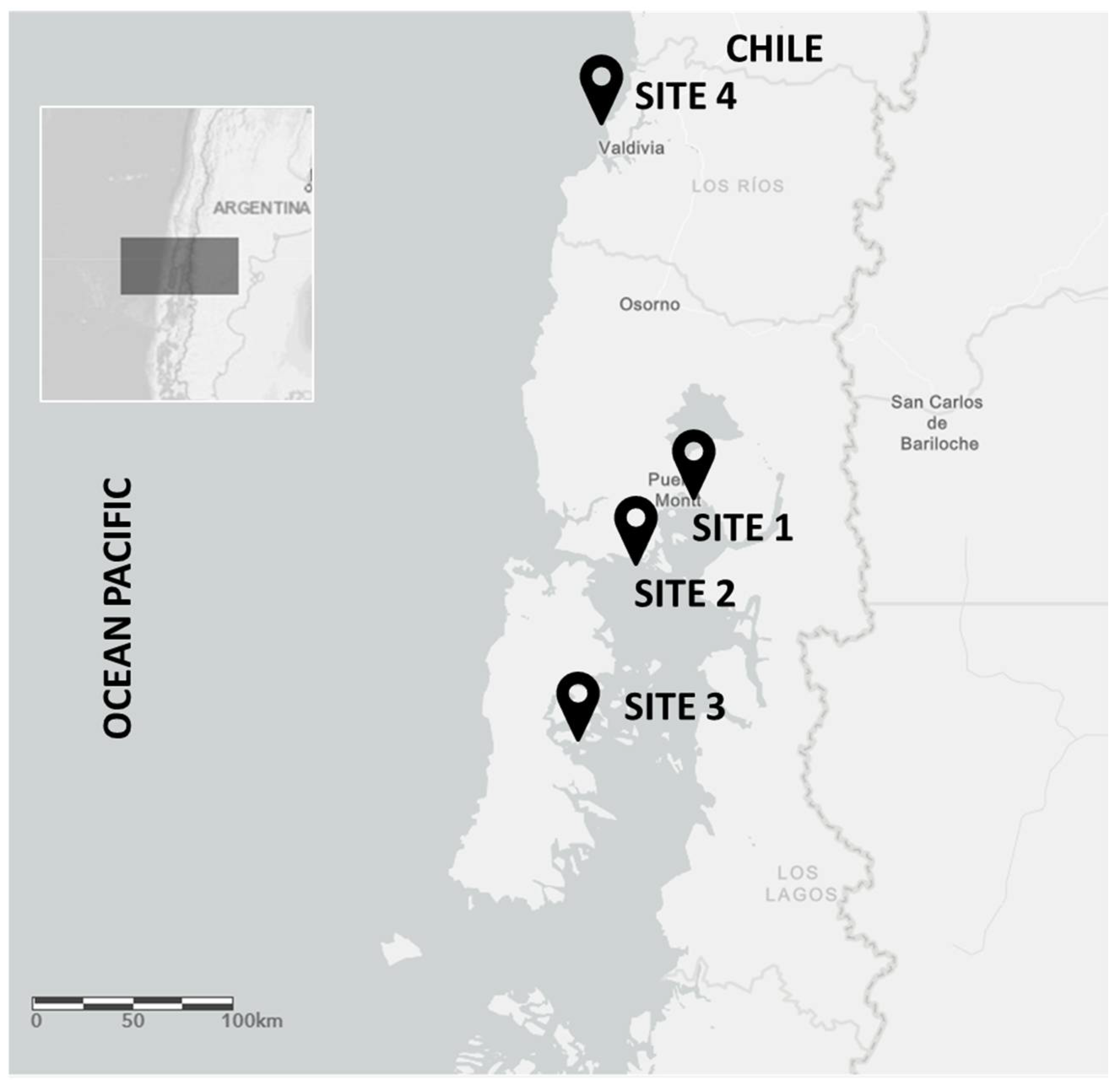
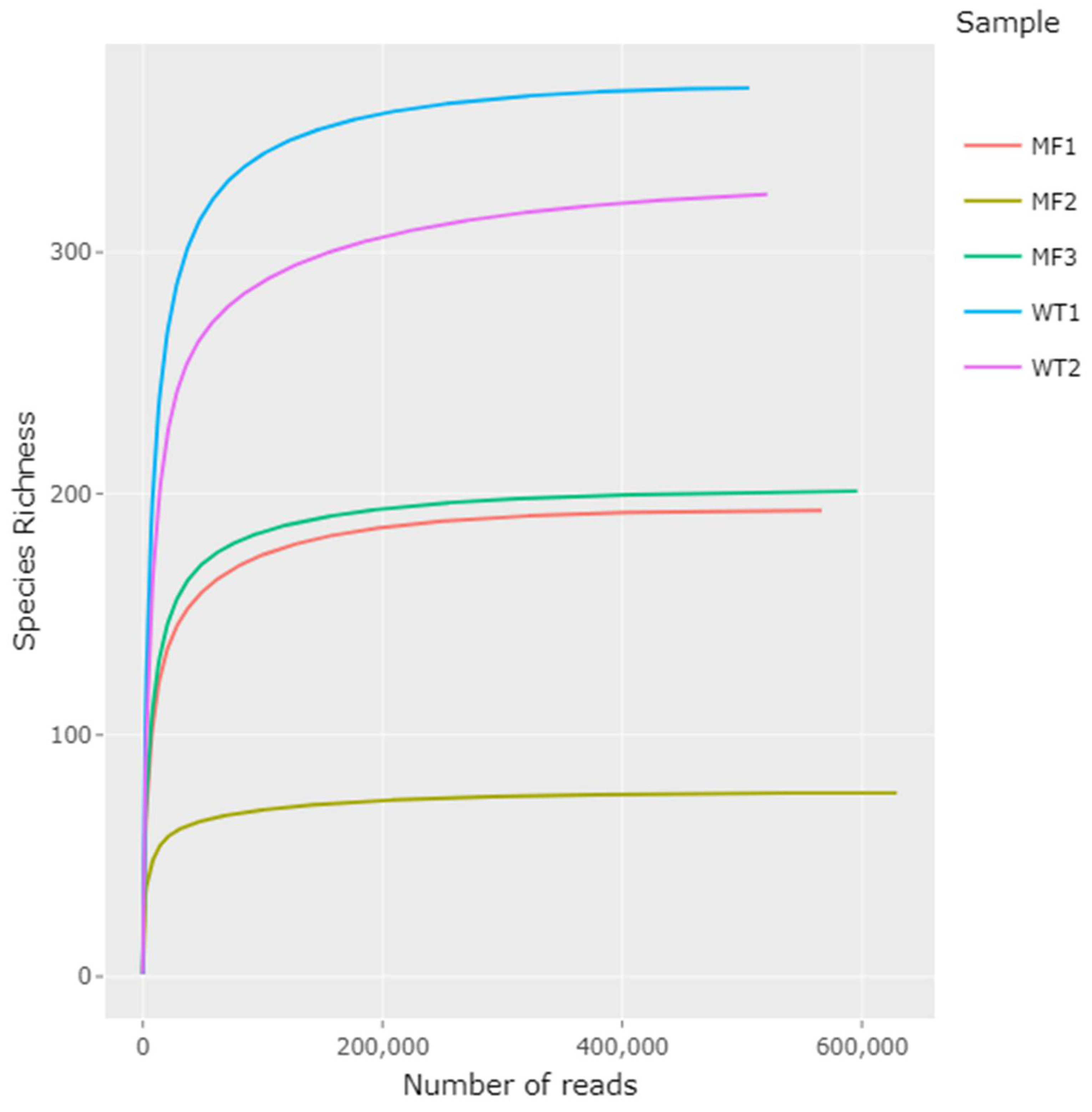
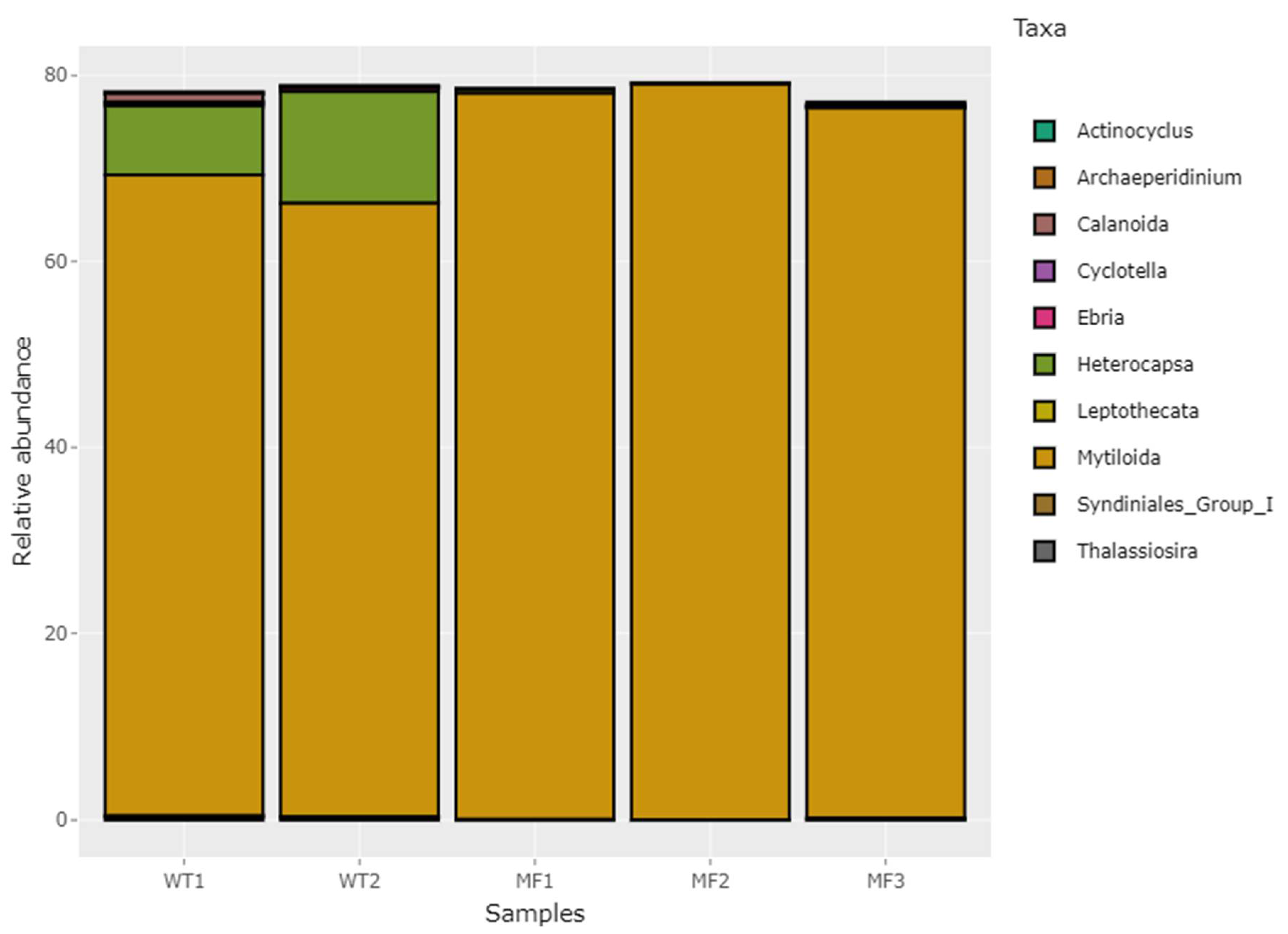
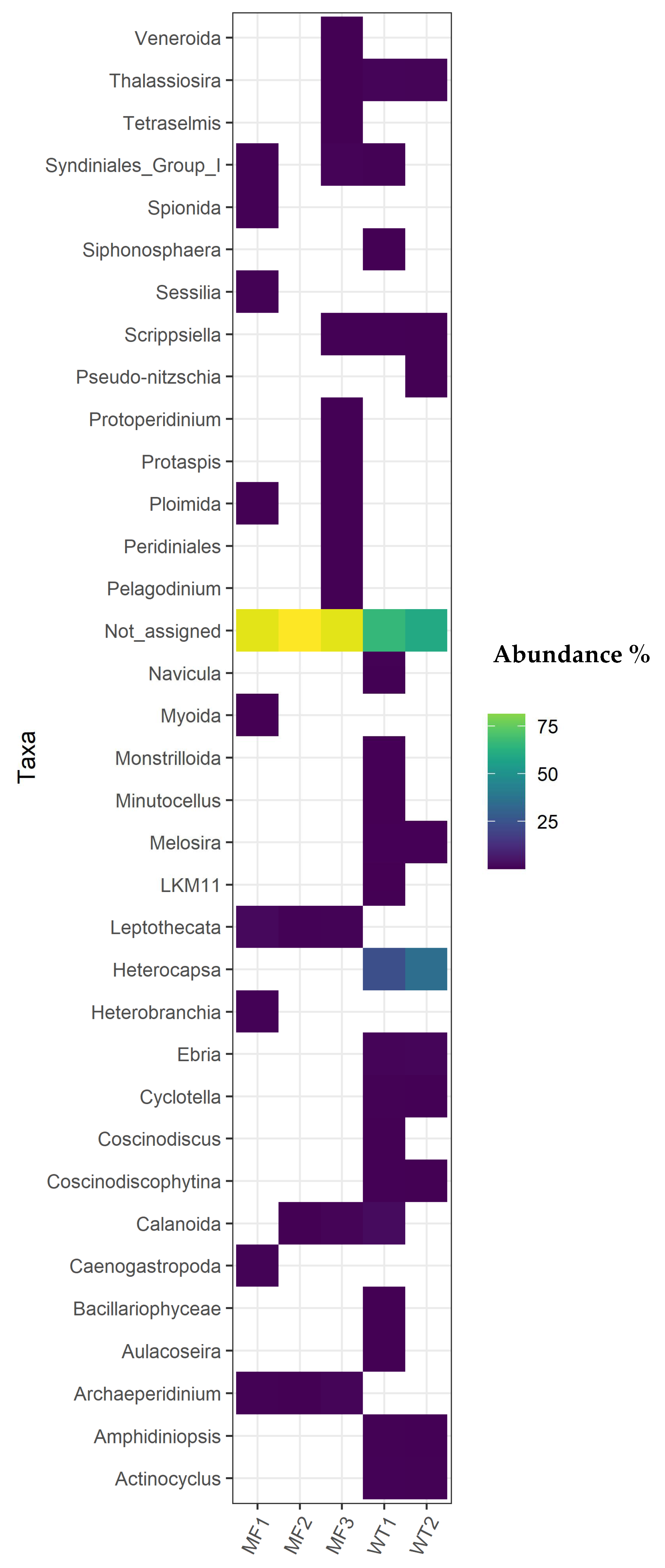
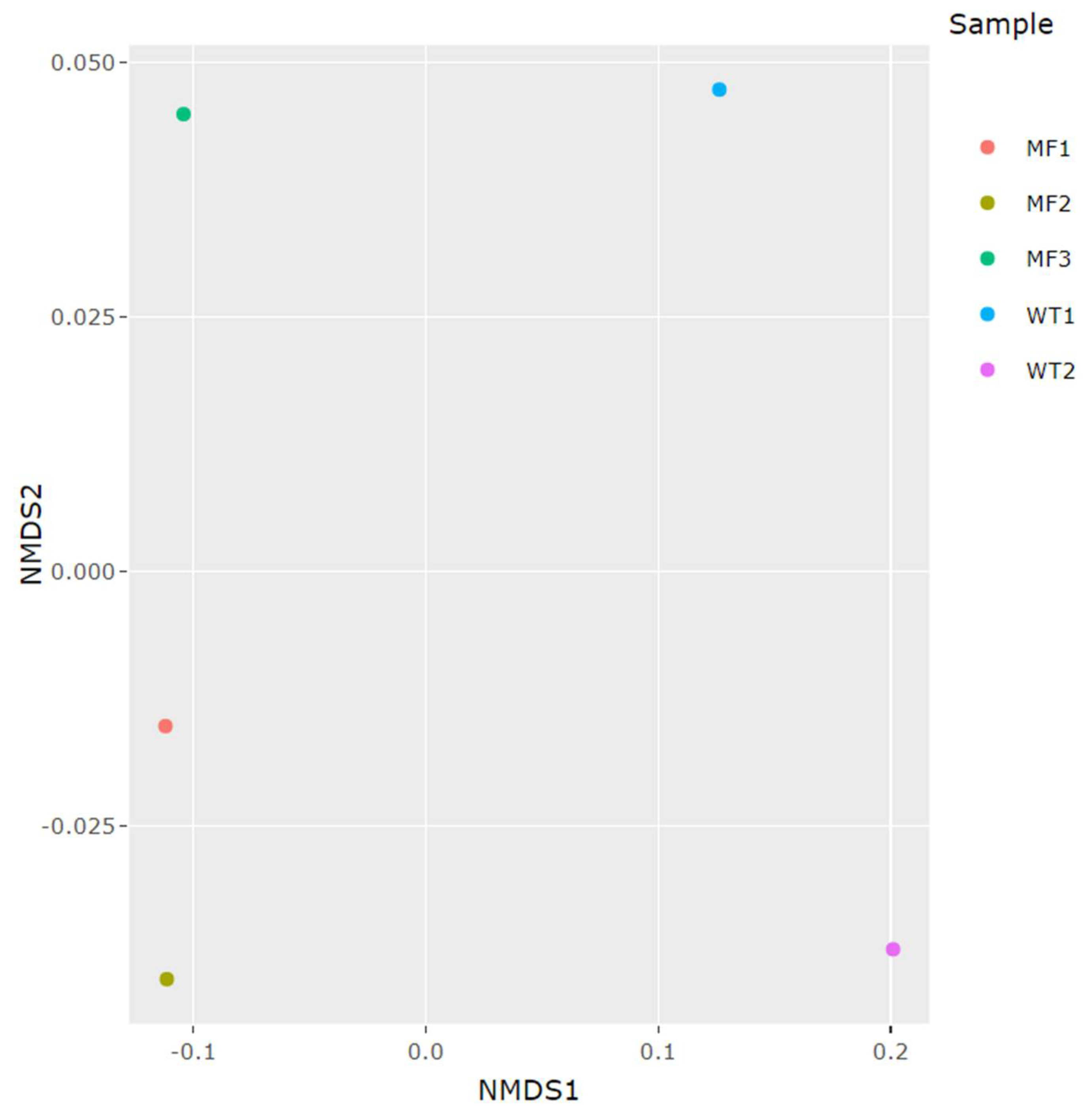
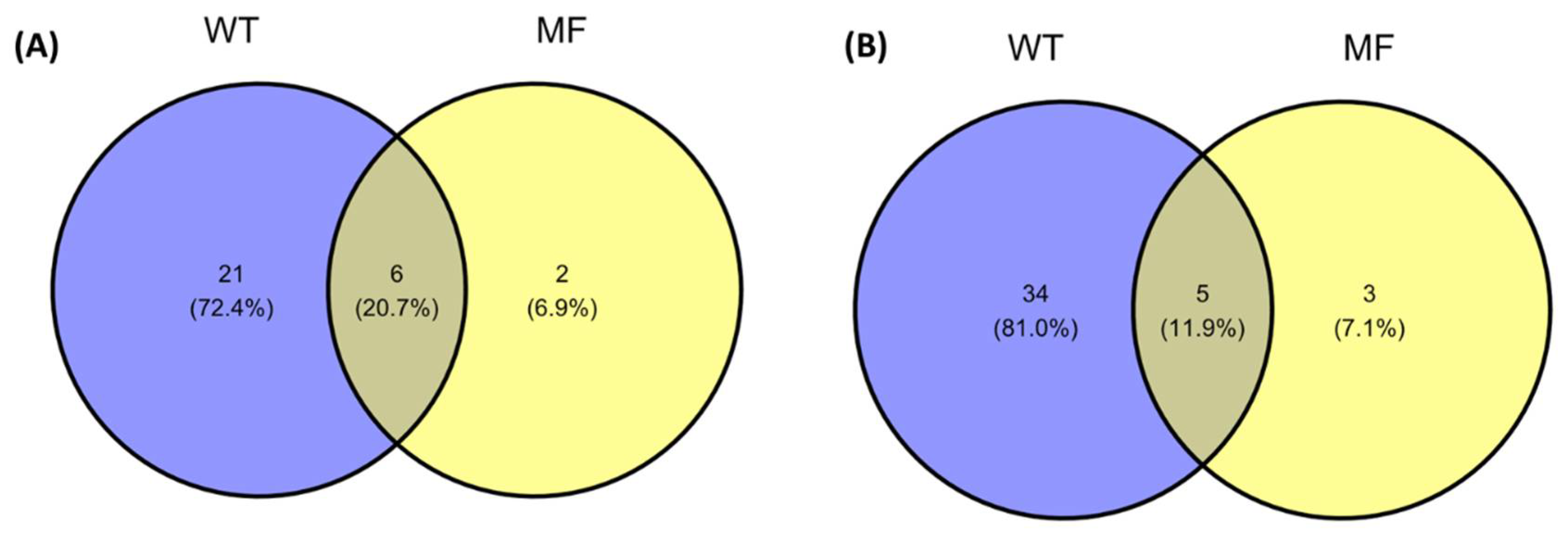
| Site | Location | Latitude (°S) | Longitude (°W) | Season | PH | Salinity | T °C | O2 Dissolved |
|---|---|---|---|---|---|---|---|---|
| Site 1 | Huelmo Bay | 41.677730 | 73.048031 | Spring | 8.2 | 32.5 | 10.1 | 8.1 |
| Site 2 | Codihue Bay | 41.778566 | 73.373335 | Spring | 7.7 | 30.8 | 9.9 | 8.4 |
| Site 3 | Quinchao Island | 42.487768 | 73.527073 | Spring | 7.7 | 31.3 | 10.2 | 7.3 |
| Site 4 | Calfuco | 39.789.288 | 73.391.704 | Spring | 7.8 | 32.5 | 12.2 | 7.4 |
| Site | Sample | E. coli MPN/100 g | Salmonella spp. P/A 25 g | V. parahaemolyticus MPN/100 g |
|---|---|---|---|---|
| Site 1 | 1 | 80 | Absence | <0.3 |
| 2 | 50 | Absence | <0.3 | |
| 3 | 90 | Absence | <0.3 | |
| 4 | 60 | Absence | <0.3 | |
| 5 | 80 | Absence | <0.3 | |
| Site 2 | 1 | 80 | Absence | <0.3 |
| 2 | 70 | Absence | <0.3 | |
| 3 | 60 | Absence | <0.3 | |
| 4 | 80 | Absence | <0.3 | |
| 5 | 70 | Absence | <0.3 | |
| Site 3 | 1 | 20 | Absence | <0.3 |
| 2 | 10 | Absence | <0.3 | |
| 3 | <0.3 | Absence | <0.3 | |
| 4 | 10 | Absence | <0.3 | |
| 5 | <0.3 | Absence | <0.3 |
| Site | Pathogen | Samples Analyzed | PCR Detection * |
|---|---|---|---|
| S1 | Bonamia spp. | 30 | n.d. |
| M. refringens | n.d. | ||
| AbHV | n.d. | ||
| X. californiensis | n.d. | ||
| OsHV-1 | n.d. | ||
| Perkinsus spp. | n.d. | ||
| S2 | Bonamia spp. | 30 | n.d. |
| M. refringens | n.d. | ||
| AbHV | n.d. | ||
| X. californiensis | n.d. | ||
| OsHV-1 | n.d. | ||
| Perkinsus spp. | n.d. | ||
| S3 | Bonamia spp. | 30 | n.d. |
| M. refringens | n.d. | ||
| AbHV | n.d. | ||
| X. californiensis | n.d. | ||
| OsHV-1 | n.d. | ||
| Perkinsus spp. | n.d. |
| Site | Sample * | Input | Reads Filtered | Reads Merged | Non Chimeras | No. of Genera | No. of Family | Shannon-Wiener Index | Simpson Index |
|---|---|---|---|---|---|---|---|---|---|
| 3 | MF1 | 1,038,053 | 828,653 | 737,414 | 566,455 | 27 | 26 | 3.11 | 0.95 |
| 3 | MF2 | 942,997 | 789,981 | 788,394 | 629,065 | 14 | 11 | 3.00 | 0.94 |
| 3 | MF3 | 994,332 | 820,426 | 817,042 | 596,117 | 31 | 27 | 3.18 | 0.95 |
| 4 | WT1 | 999,049 | 788,556 | 782,046 | 506,051 | 63 | 49 | 3.46 | 0.96 |
| 4 | WT2 | 1,042,958 | 826,767 | 821,658 | 521,142 | 66 | 42 | 3.41 | 0.96 |
Publisher’s Note: MDPI stays neutral with regard to jurisdictional claims in published maps and institutional affiliations. |
© 2022 by the authors. Licensee MDPI, Basel, Switzerland. This article is an open access article distributed under the terms and conditions of the Creative Commons Attribution (CC BY) license (https://creativecommons.org/licenses/by/4.0/).
Share and Cite
Santibáñez, P.; Romalde, J.; Fuentes, D.; Figueras, A.; Figueroa, J. Health Status of Mytilus chilensis from Intensive Culture Areas in Chile Assessed by Molecular, Microbiological, and Histological Analyses. Pathogens 2022, 11, 494. https://doi.org/10.3390/pathogens11050494
Santibáñez P, Romalde J, Fuentes D, Figueras A, Figueroa J. Health Status of Mytilus chilensis from Intensive Culture Areas in Chile Assessed by Molecular, Microbiological, and Histological Analyses. Pathogens. 2022; 11(5):494. https://doi.org/10.3390/pathogens11050494
Chicago/Turabian StyleSantibáñez, Pablo, Jesús Romalde, Derie Fuentes, Antonio Figueras, and Jaime Figueroa. 2022. "Health Status of Mytilus chilensis from Intensive Culture Areas in Chile Assessed by Molecular, Microbiological, and Histological Analyses" Pathogens 11, no. 5: 494. https://doi.org/10.3390/pathogens11050494
APA StyleSantibáñez, P., Romalde, J., Fuentes, D., Figueras, A., & Figueroa, J. (2022). Health Status of Mytilus chilensis from Intensive Culture Areas in Chile Assessed by Molecular, Microbiological, and Histological Analyses. Pathogens, 11(5), 494. https://doi.org/10.3390/pathogens11050494









